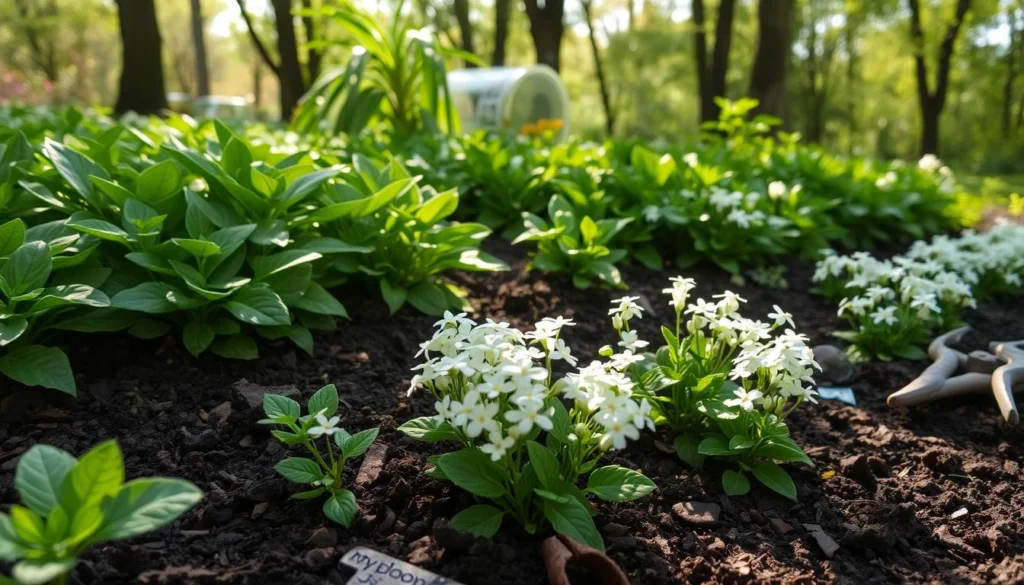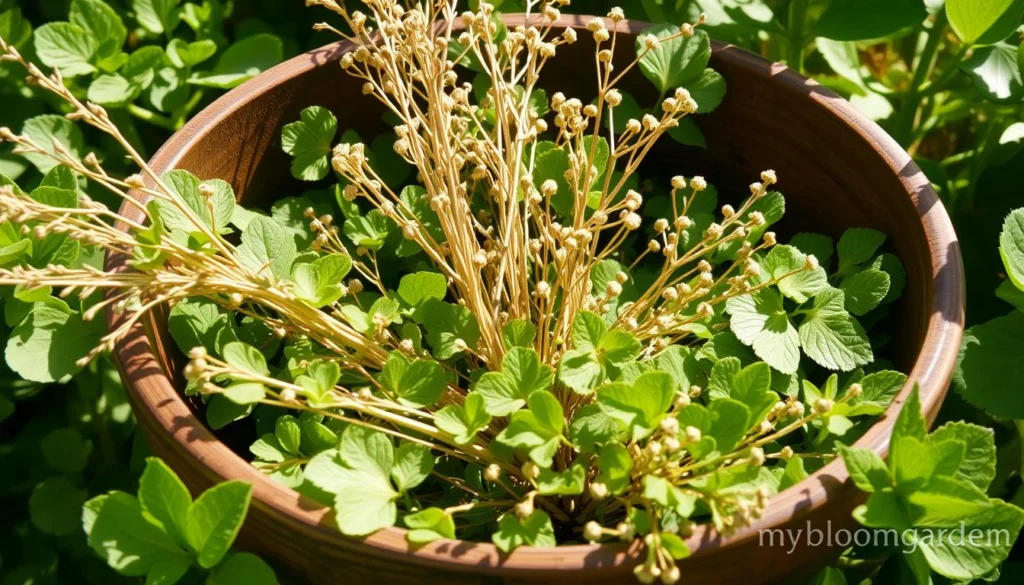As summer sun warms the garden, a lush green carpet catches your eye. A familiar scent, like a long-lost friend, fills the air. This is the world of sweet woodruff, loved by gardeners and cooks for years.
In this guide, we’ll explore growing and caring for this fragrant herb. You’ll learn about its history and uses. Discover why woodruff is a must-have in your garden and home. Let’s dive into the world of this remarkable plant.
Table of Contents
Introduction to Sweet Woodruff: Nature’s Ground Cover
Exploring woodruff herb, also known as Galium odoratum, opens up a world of wonder. This fragrant perennial is loved for its lush green leaves and delicate white flowers. It’s a versatile ground cover that beautifies gardens.
Origins and History
Woodruff plant comes from Europe and Asia. It’s been valued for centuries, with uses dating back to the Middle Ages. It’s been part of folklore, cooking, and even dye-making.
Traditional Uses Through Time
- In traditional medicine, what is woodruff has treated many issues, like digestive and circulatory problems.
- Cooks use its leaves and flowers for unique flavors in drinks, desserts, and sauces.
- Its ability to create dyes has been used in textiles for ages.
Key Characteristics
The woodruff herb stands out with its whorled leaves, white flowers, and a sweet, vanilla-like scent. These traits make it popular and versatile.
“The sweet, heady scent of woodruff is a true delight, evoking memories of springtime and the great outdoors.”
As you explore woodruff herb, you’ll see why it’s loved by gardeners, herbalists, and cooks. Its rich history, uses, and charm are unmatched.
Understanding Woodruff Plant Characteristics
Woodruff is a fragrant perennial herb with unique features. Its lush green foliage and delicate white flowers make it stunning in gardens or landscapes. Let’s look at what makes this plant special.
The woodruff plant grows low and spreads, forming a dense carpet. Its slender stems support whorled leaves that spread out, creating a symmetrical pattern. The leaves are bright green, oblong, and smooth.
In late spring and early summer, woodruff blooms with tiny, star-shaped white flowers. These flowers have a sweet, vanilla-like scent that fills the air. Though short-lived, their beauty is a joy for gardeners and nature lovers.
Woodruff is known for being a perennial plant. This means it comes back year after year with little care. It’s a reliable and easy-to-maintain addition to any garden.
Woodruff’s captivating look and interesting history make it a valuable perennial. Knowing its key traits helps us appreciate and grow this fragrant herb.
Ideal Growing Conditions for Sweet Woodruff
To make sure your sweet woodruff plants grow well, you need to give them the right conditions. This includes the soil, light, and temperature. Knowing what sweet woodruff likes will help your garden thrive.
Soil Requirements
Sweet woodruff loves soil that drains well and is rich in nutrients. It prefers a slightly acidic soil with a pH between 5.5 and 6.5. The soil should be loose and loamy to help water and roots grow well. Adding compost or organic matter can make the soil perfect for sweet woodruff.
Light and Temperature Needs
This plant does best in partial to full shade. It can handle some sunlight, but too much can harm it. Sweet woodruff grows best in cool to moderate temperatures, between 60°F and 75°F (15°C to 24°C).
Moisture Preferences
- Sweet woodruff likes moist soil but not too wet.
- Water it regularly to keep the soil damp but not soggy.
- Don’t let the soil dry out completely, as it can stress the plant.
By understanding and meeting sweet woodruff’s growing needs, you can have a beautiful, fragrant ground cover. It will make your garden more lovely and inviting.
“Sweet woodruff is a versatile and easy-to-grow plant that can elevate any garden with its delicate charm and captivating scent.”
Planting and Propagation Methods
Starting a new sweet woodruff patch or growing an existing one has many ways. You can use seeds, division, or stem cuttings. This herb is great for gardeners looking to add it to their space.
Seed Sowing
Sow sweet woodruff seeds in the spring or fall. Spread them lightly on moist soil and press them down. Keep the soil wet until they sprout, which takes 2-3 weeks.
Once they grow, thin them to 6-8 inches apart. This helps them grow well.
Division and Transplanting
Divide mature woodruff in spring or fall to make new plants. Dig up the plant, separate the roots, and replant. Water well and keep moist until they settle.
Stem Cuttings
- Take 4-6 inch stem cuttings from healthy woodruff plants.
- Remove lower leaves and dip in rooting hormone powder.
- Plant in well-draining mix and keep moist until new growth.
- Transplant once rooted.
Choose your sweet woodruff planting method wisely. Make sure the plant gets what it needs for the best results. With some care, you can grow beautiful woodruff plants in your garden.

“Woodruff is a versatile and easy-to-grow ground cover that adds a lovely fragrance and texture to any garden.”
Essential Care Tips for Woodruff Plants
Proper care is key for your woodruff plants to grow well and smell great. We’ll cover watering, pruning, and more to help your plants flourish.
Watering Schedule
Woodruff plants like moist soil but not too wet. Water them often to keep the soil damp. Don’t let the soil dry out completely. In hot weather, water more to prevent leaf wilting.
Fertilization Guidelines
Use a balanced fertilizer in early spring to help your woodruff herb grow strong. You can also use liquid fertilizer every few weeks during the growing season. But don’t overdo it, as too much fertilizer can harm the plant’s scent.
Pruning Techniques
- Prune your woodruff plants regularly to keep them bushy and healthy.
- Use sharp scissors or pruning shears to cut off dead or damaged stems.
- Prune in spring or early summer, before they bloom.
- Don’t cut too much, as it can hurt the roots and slow growth.
Follow these woodruff plant care tips to enjoy their beautiful leaves, flowers, and scent in your garden.
Harvesting and Drying Woodruff
Harvesting and drying your dried woodruff or woodruff herb is key. It keeps its special smell and strength. Follow these steps to keep your dried woodruff flavorful and fragrant.
The best time to pick woodruff herb is just before it blooms. This is in late spring or early summer. At this time, the leaves have the most of the scent compound.
- Cut the woodruff stems 2-3 inches above the ground. Make sure to avoid the woody base.
- Gently shake or brush off any dirt or debris clinging to the leaves and stems.
- Gather the freshly harvested woodruff into small bundles. Hang them upside down in a well-ventilated, shady area.
Drying woodruff right is key to keep its smell and taste. It usually takes 7-10 days to dry completely. This depends on the humidity and air flow in your drying spot.
“Proper drying is the key to unlocking the full potential of your dried woodruff.”
After the woodruff is dry, gently remove the leaves from the stems. Store them in an airtight container in a cool, dark place. This keeps the woodruff‘s smell and strength for later use.

By following these easy steps, you can keep your dried woodruff smelling and tasting great. It’s ready to use in many dishes and scents.
Common Uses of Woodruff in Gardens and Homes
The woodruff herb is not just beautiful and fragrant. It also has many uses in gardens and homes. It can make your food taste better and even help with health issues.
Culinary Applications
Woodruff tastes like vanilla and fresh grass. It’s a favorite in many European dishes. You can use its leaves to make teas, syrups, and even drinks like Maiwein.
It’s also great in salads, soups, and baked goods. It adds a unique flavor and smell to many dishes.
Medicinal Properties
Woodruff has been used for health for a long time. It might help with headaches, blood flow, and even sleep. Some research shows it could fight inflammation and protect against damage.
Decorative Uses
- Ground Cover: Woodruff is a great ground cover. It looks good and grows low to the ground.
- Cut Flowers: Its star-shaped flowers are perfect for bouquets and arrangements.
- Fragrance: Use its scent in sachets, potpourri, and air fresheners. It makes your home smell nice.
Looking to improve your cooking, health, or garden? Woodruff herb is a great choice. It’s versatile and adds beauty to your life.
Troubleshooting Common Woodruff Problems
Keeping your woodruff plants healthy is key to a great garden. Even the best gardeners face problems sometimes. Let’s look at common issues with woodruff plant care and find ways to fix them.
Pests and Diseases
Pests like aphids, mites, or slugs can harm woodruff plants. These pests can damage leaves and slow growth. Check your plants often and fix problems fast to avoid bigger issues.
Environmental Stressors
Woodruff plants are tough but can still face environmental challenges. Too much heat, drought, or bad soil can hurt them. Make sure your woodruff plants get enough water, sunlight, and good soil.
Troubleshooting Strategies
- Watch your woodruff plants for pests or diseases.
- Use natural pest control or change their environment if needed.
- Give your woodruff plants the right water, sunlight, and nutrients.
- Trim and thin plants if they’re too crowded or long.
- Ask a gardening expert if problems keep coming back.
By being careful and quick to solve problems, your woodruff plants will stay healthy. With the right care, these herbs will make your garden more beautiful and fragrant.
Companion Planting with Sweet Woodruff
Adding the woodruff flower (Galium odoratum) to your garden can change the game. It loves shaded spots and is great as a ground cover. It also helps other plants grow better.
Best Plant Combinations
Woodruff looks great with plants that love shade, like hostas and ferns. Its lacy leaves add a nice contrast to these plants. Plus, it keeps weeds away, helping delicate plants grow.
Garden Design Tips
- Use woodruff as a groundcover in shaded areas, allowing it to cascade over the edges of raised beds or borders.
- Combine woodruff with taller, upright plants like ferns or hostas to create a layered, textured look.
- Plant woodruff around the base of trees or shrubs to provide a natural, living mulch that helps retain moisture and suppress weeds.
- Incorporate woodruff into woodland-inspired gardens, where its fragrant blooms and lush foliage can thrive in the dappled shade.
By adding sweet woodruff to your garden, you create a beautiful and harmonious space. It celebrates the beauty of this versatile perennial.
“Woodruff is a wonderful addition to any shaded garden, providing a lush, green carpet that complements a variety of companion plants.”
Conclusion
Growing sweet woodruff (Galium odoratum) is rewarding for gardeners and herb lovers. It has beautiful foliage, delicate white flowers, and many uses. It’s great for cooking, medicine, and decoration.
To grow sweet woodruff well, know the best conditions, how to plant and care for it. It can be a ground cover, a tasty ingredient, or a pretty decoration. It adds beauty and function to any space.
Keep exploring sweet woodruff’s unique qualities. It can make your garden and life better. With this guide, you’re ready to enjoy this fragrant herb for many years.

